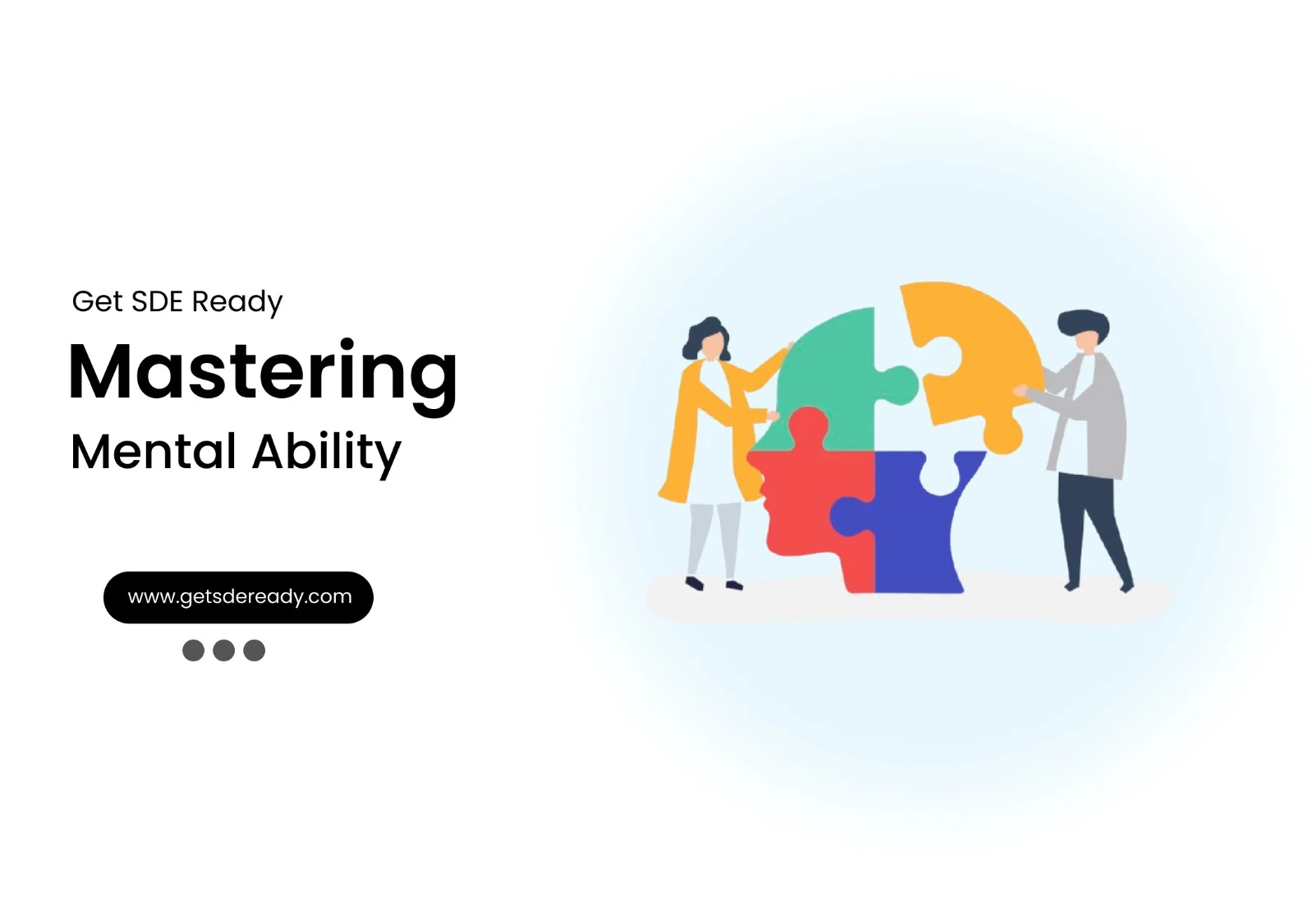Data Structures and Algorithms
- Introduction to Data Structures and Algorithms
- Time and Space Complexity Analysis
- Big-O, Big-Theta, and Big-Omega Notations
- Recursion and Backtracking
- Divide and Conquer Algorithm
- Dynamic Programming: Memoization vs. Tabulation
- Greedy Algorithms and Their Use Cases
- Understanding Arrays: Types and Operations
- Linear Search vs. Binary Search
- Sorting Algorithms: Bubble, Insertion, Selection, and Merge Sort
- QuickSort: Explanation and Implementation
- Heap Sort and Its Applications
- Counting Sort, Radix Sort, and Bucket Sort
- Hashing Techniques: Hash Tables and Collisions
- Open Addressing vs. Separate Chaining in Hashing
- DSA Questions for Beginners
- Advanced DSA Questions for Competitive Programming
- Top 10 DSA Questions to Crack Your Next Coding Test
- Top 50 DSA Questions Every Programmer Should Practice
- Top Atlassian DSA Interview Questions
- Top Amazon DSA Interview Questions
- Top Microsoft DSA Interview Questions
- Top Meta (Facebook) DSA Interview Questions
- Netflix DSA Interview Questions and Preparation Guide
- Top 20 DSA Interview Questions You Need to Know
- Top Uber DSA Interview Questions and Solutions
- Google DSA Interview Questions and How to Prepare
- Airbnb DSA Interview Questions and How to Solve Them
- Mobile App DSA Interview Questions and Solutions
DSA Interview Questions
- DSA Questions for Beginners
- Advanced DSA Questions for Competitive Programming
- Top 10 DSA Questions to Crack Your Next Coding Test
- Top 50 DSA Questions Every Programmer Should Practice
- Top Atlassian DSA Interview Questions
- Top Amazon DSA Interview Questions
- Top Microsoft DSA Interview Questions
- Top Meta (Facebook) DSA Interview Questions
- Netflix DSA Interview Questions and Preparation Guide
- Top 20 DSA Interview Questions You Need to Know
- Top Uber DSA Interview Questions and Solutions
- Google DSA Interview Questions and How to Prepare
- Airbnb DSA Interview Questions and How to Solve Them
- Mobile App DSA Interview Questions and Solutions
Data Structures and Algorithms
- Introduction to Data Structures and Algorithms
- Time and Space Complexity Analysis
- Big-O, Big-Theta, and Big-Omega Notations
- Recursion and Backtracking
- Divide and Conquer Algorithm
- Dynamic Programming: Memoization vs. Tabulation
- Greedy Algorithms and Their Use Cases
- Understanding Arrays: Types and Operations
- Linear Search vs. Binary Search
- Sorting Algorithms: Bubble, Insertion, Selection, and Merge Sort
- QuickSort: Explanation and Implementation
- Heap Sort and Its Applications
- Counting Sort, Radix Sort, and Bucket Sort
- Hashing Techniques: Hash Tables and Collisions
- Open Addressing vs. Separate Chaining in Hashing
- DSA Questions for Beginners
- Advanced DSA Questions for Competitive Programming
- Top 10 DSA Questions to Crack Your Next Coding Test
- Top 50 DSA Questions Every Programmer Should Practice
- Top Atlassian DSA Interview Questions
- Top Amazon DSA Interview Questions
- Top Microsoft DSA Interview Questions
- Top Meta (Facebook) DSA Interview Questions
- Netflix DSA Interview Questions and Preparation Guide
- Top 20 DSA Interview Questions You Need to Know
- Top Uber DSA Interview Questions and Solutions
- Google DSA Interview Questions and How to Prepare
- Airbnb DSA Interview Questions and How to Solve Them
- Mobile App DSA Interview Questions and Solutions
DSA Interview Questions
- DSA Questions for Beginners
- Advanced DSA Questions for Competitive Programming
- Top 10 DSA Questions to Crack Your Next Coding Test
- Top 50 DSA Questions Every Programmer Should Practice
- Top Atlassian DSA Interview Questions
- Top Amazon DSA Interview Questions
- Top Microsoft DSA Interview Questions
- Top Meta (Facebook) DSA Interview Questions
- Netflix DSA Interview Questions and Preparation Guide
- Top 20 DSA Interview Questions You Need to Know
- Top Uber DSA Interview Questions and Solutions
- Google DSA Interview Questions and How to Prepare
- Airbnb DSA Interview Questions and How to Solve Them
- Mobile App DSA Interview Questions and Solutions
Cloud Computing for Software Development Engineers: AWS, Azure, and GCP Roadmap
As a software development engineer (SDE), diving into cloud computing isn’t just about keeping up with trends—it’s about transforming how you build, deploy, and scale applications in today’s fast-paced tech world. Whether you’re optimizing code for distributed systems or integrating AI-driven features, mastering platforms like AWS, Azure, and GCP can supercharge your career. To stay ahead with free courses and the latest updates on cloud technologies, sign up for our newsletter and unlock valuable resources tailored for developers like you.
In this guide, we’ll explore a step-by-step roadmap designed specifically for SDEs, drawing from the latest 2025 insights. With the global cloud computing market hitting $912.77 billion this year and projected to reach $1.614 trillion by 2030, according to recent industry reports, cloud skills are non-negotiable. We’ll break down key concepts, compare major providers, and offer actionable advice to help you level up. By the end, you’ll have a clear path to proficiency, complete with hands-on projects and certification tips.
Why Cloud Computing Matters for SDEs in 2025
Cloud computing has evolved from a buzzword to the backbone of modern software engineering. As an SDE, you’re likely already dealing with microservices, containerization, and scalable architectures—cloud platforms make these realities efficient and cost-effective.
Consider the stats: By 2025, 94% of organizations are using cloud infrastructure in some capacity, up from previous years, as per cloud migration reports. Moreover, 50% of all global data will be stored in the cloud by year’s end, highlighting the shift toward data-driven development. Expert Satya Nadella, CEO of Microsoft, once noted, “Every company is a software company,” underscoring how cloud empowers SDEs to focus on innovation rather than infrastructure.
For SDEs, cloud knowledge means:
- Faster Development Cycles: Deploy code in minutes using serverless architectures.
- Cost Efficiency: Pay only for what you use, reducing overhead in projects.
- Scalability: Handle spikes in traffic without rewriting core logic.
- Collaboration: Enable seamless DevOps workflows across teams.
If you’re new to this, start by understanding core models: Infrastructure as a Service (IaaS) for virtual machines, Platform as a Service (PaaS) for app hosting, and Software as a Service (SaaS) for ready-to-use tools. Hybrid and multi-cloud setups are increasingly popular, with 33% of enterprises spending over $12 million annually on public clouds, per Flexera’s 2025 State of the Cloud Report.
Actionable tip: Assess your current projects—could they benefit from cloud migration? Begin small by containerizing a simple app with Docker, a skill that pairs well with cloud platforms.
Overview of Major Cloud Providers: AWS, Azure, and GCP
The “Big Three” dominate the market in 2025, with AWS holding about 31% share, Azure at 22%, and GCP at 12%, based on Q1 2025 data from Canalys and other analysts. Each excels in different areas, so choosing one depends on your tech stack and goals.
Amazon Web Services (AWS): The Market Leader
AWS, launched in 2006, remains the go-to for its vast ecosystem. It’s ideal for SDEs working on e-commerce or big data, boasting over 200 services.
Key strengths:
- Compute: EC2 for virtual servers, Lambda for serverless functions.
- Storage: S3 for object storage, EBS for block-level.
- AI/ML: SageMaker for building models.
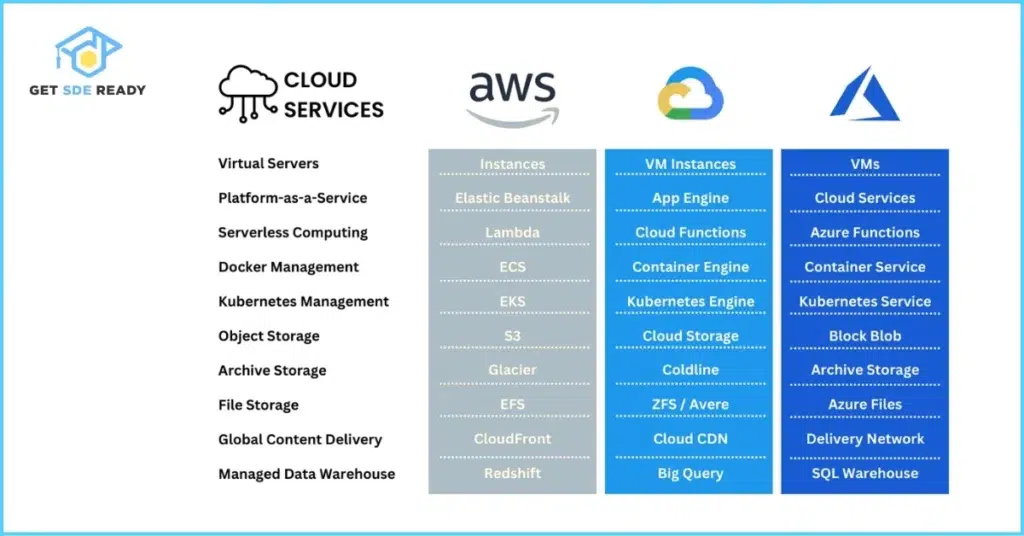
In 2025, AWS’s revenue grew 17% year-over-year, fueled by AI integrations. As Jeff Bezos put it, “AWS is customer-obsessed,” which shows in its reliability—99.99% uptime SLAs.
For SDEs, AWS shines in DevOps with tools like CodePipeline. If you’re into algorithms for optimization, pair this with our DSA course to enhance cloud-based sorting and searching efficiencies.
Microsoft Azure: Seamless Integration for Enterprise
Azure, with its 25% growth in Q1 2025, appeals to SDEs in Windows-heavy environments or those using .NET. It’s strong in hybrid cloud, blending on-prem and cloud seamlessly.
Highlights:
- Compute: Virtual Machines and Azure Functions.
- Storage: Blob Storage and Azure Disks.
- Databases: Cosmos DB for NoSQL, SQL Database for relational.
Azure’s market share has doubled in five years, per Trusted Tech Team, thanks to integrations with Microsoft 365. Expert quote from Gartner: “Azure’s hybrid capabilities make it a natural choice for enterprises modernizing legacy systems.”
SDEs love Azure DevOps for CI/CD pipelines. If web development is your focus, check our web development course to build full-stack apps deployable on Azure.
Google Cloud Platform (GCP): Data and AI Powerhouse
GCP, growing at 28% in recent quarters, excels in data analytics and machine learning—perfect for SDEs in AI-driven projects.
Core features:
- Compute: Compute Engine and Cloud Functions.
- Storage: Cloud Storage and Persistent Disk.
- Big Data: BigQuery for analytics, Vertex AI for ML.
With 12% market share, GCP’s strength lies in open-source friendliness, like Kubernetes (which it invented). As Google Cloud CEO Thomas Kurian states, “GCP is built for the future of AI and data.”
For SDEs, tools like Anthos enable multi-cloud management. If data science intrigues you, our data science course complements GCP’s analytics services.
Building Your Cloud Computing Roadmap as an SDE
Learning cloud isn’t overwhelming if broken into phases. This 2025 roadmap, inspired by resources like GeeksforGeeks and DataCamp, spans 6-12 months, assuming 10-15 hours weekly.
Beginner Level: Foundations (1-2 Months)
Start with basics to avoid common pitfalls like misconfigured security.
Steps:
- Learn cloud models (IaaS, PaaS, SaaS) via free trials on all platforms.
- Master networking: VPCs, subnets, firewalls.
- Programming prerequisites: Python or Java for scripting—refresh with our crash course.
- Set up accounts: Create free-tier AWS, Azure, and GCP profiles.
Resources: AWS Free Tier, Azure for Students, GCP’s Qwiklabs. Aim for 20-30 hours of labs.
Actionable: Deploy a static website on S3 or Blob Storage.
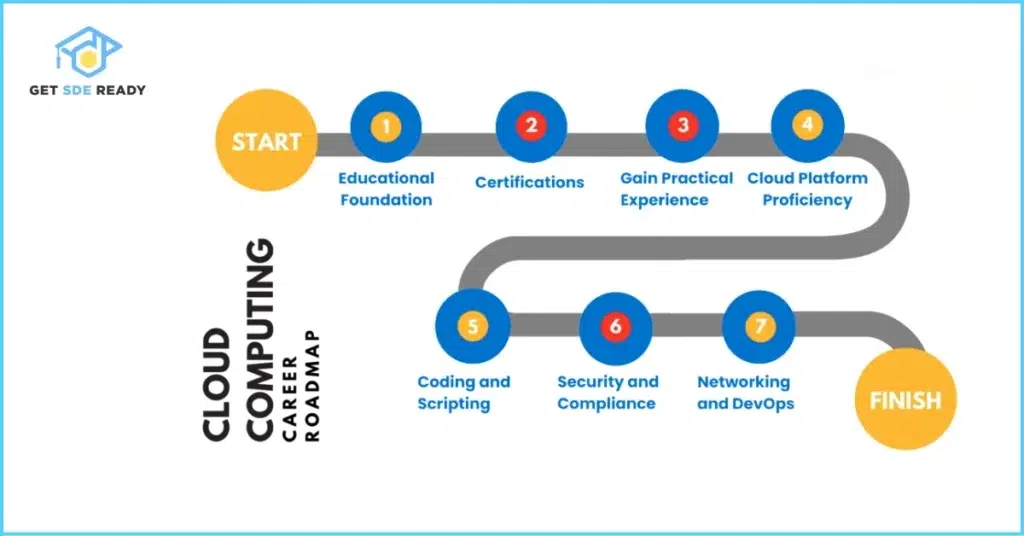
Intermediate Level: Core Services and Integration (3-4 Months)
Dive into platform-specific services while building integrations.
Focus areas:
- Compute: Launch EC2 instances, Azure VMs, or GCP Compute Engines.
- Storage and Databases: Use S3 for files, DynamoDB/Cosmos DB/BigTable for data.
- DevOps Basics: CI/CD with Jenkins or native tools like AWS CodeBuild.
- Security: IAM roles, Azure AD, GCP IAM.
Experiment with multi-cloud: Sync data between AWS and GCP.
Tip: For system design in cloud architectures, our master DSA, web dev, and system design course provides in-depth scaling strategies.
Projects: Build a REST API with Lambda/Functions and a NoSQL backend.
Advanced Level: Optimization and Specialization (3-4 Months)
Tackle real-world scenarios like cost management and AI.
Advanced topics:
- Serverless and Containers: Kubernetes on EKS/AKS/GKE.
- Monitoring: CloudWatch, Azure Monitor, Stackdriver.
- AI/ML Integration: Deploy models with SageMaker or Vertex AI.
- Cost Optimization: Use AWS Cost Explorer or GCP Billing.
In 2025, AI fuels 30% efficiency boosts, per Forrester. Overcome challenges like vendor lock-in by learning Terraform for IaC.
Certifications: Earn AWS Certified Developer – Associate, Azure Developer Associate, or GCP Professional Cloud Developer. These boost salaries by 20-30%, according to Refonte Learning.
Key Services and Concepts Across Platforms
To compare effectively, here’s a breakdown of essential services for SDEs.
Compute Services
- AWS EC2: Flexible VMs with auto-scaling.
- Azure Virtual Machines: Windows-optimized, spot instances for savings.
- GCP Compute Engine: Custom machine types for cost efficiency.
All support serverless: Lambda vs. Functions vs. Cloud Functions. Choose based on language support—GCP excels in Go and Python.
Storage Solutions
- AWS S3: Durable object storage, 99.999999999% durability.
- Azure Blob: Hierarchical namespaces for large datasets.
- GCP Cloud Storage: Unified buckets with lifecycle management.
For SDEs handling big data, integrate with analytics tools.
Databases
- AWS RDS/DynamoDB: Managed relational/NoSQL.
- Azure SQL/Cosmos DB: Global distribution.
- GCP Cloud SQL/Spanner: Horizontally scalable.
Stats show 60% of apps use managed DBs for ease.
Networking
- AWS VPC: Isolated networks.
- Azure Virtual Network: Peering for hybrids.
- GCP VPC: Global routing.
Security tip: Always enable encryption in transit.
Security and Identity
All offer robust IAM, but Azure integrates best with enterprise AD. Common best practice: Least privilege access.
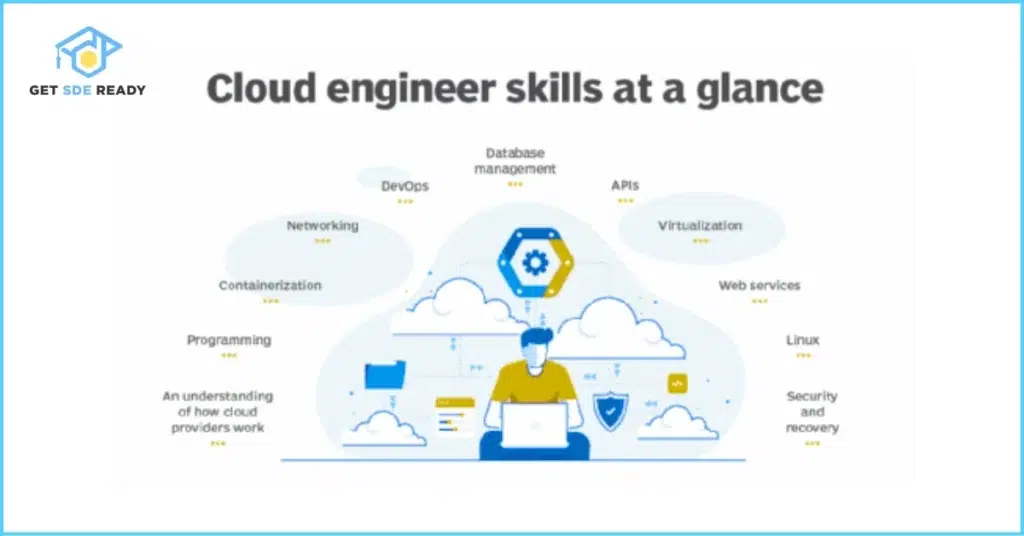
Hands-On Projects and Best Practices
Theory alone won’t cut it—projects build experience.
Beginner Project: Deploy a full-stack app (e.g., Node.js backend, React frontend) on EC2/VM/Compute Engine. Use our web dev course for the app base.
Intermediate: Set up a CI/CD pipeline for a microservices app, auto-deploying to Kubernetes.
Advanced: Build an AI chatbot using Lambda and Bedrock (AWS’s new AI service in 2025), monitoring costs.
Best practices:
- Version Control: Git with cloud repos.
- Monitoring: Set alerts for anomalies.
- Cost Management: Tag resources, use savings plans.
- Security: Regular audits, zero-trust models.
Common challenge: Over-provisioning—solve by rightsizing with tools like AWS Compute Optimizer.
Career Opportunities and Certifications for SDEs
Cloud-savvy SDEs are in demand: Roles like Cloud Engineer or DevOps Specialist pay $120K-$180K, per 2025 reports.
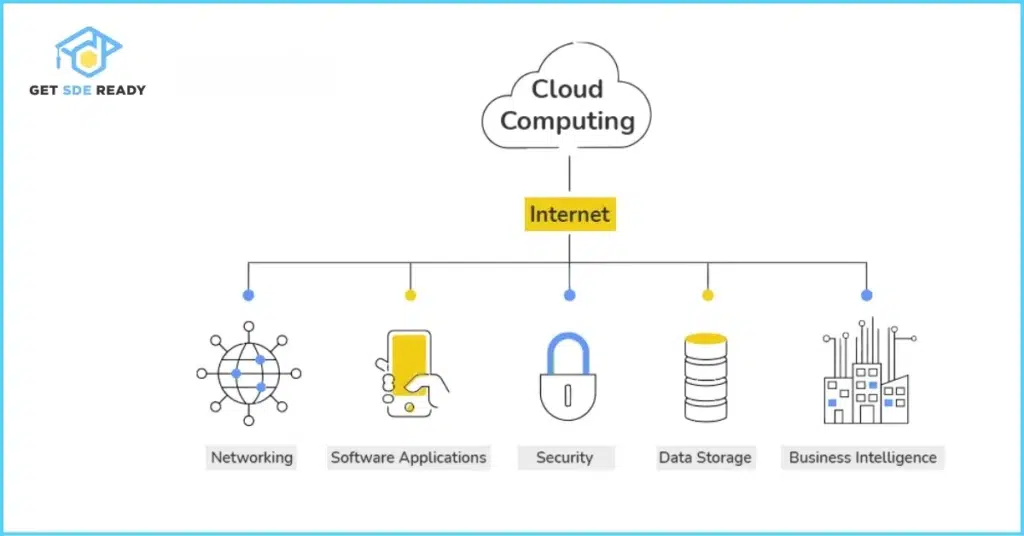
Top certifications:
- AWS: Certified Solutions Architect – Associate (tests deployment skills).
- Azure: AZ-204 Developer Associate.
- GCP: Professional Cloud Architect.
Prep tip: Use practice exams and labs. With multi-cloud skills, you could land roles at FAANG.
Call to action: Ready to accelerate? Enroll in specialized courses to bridge gaps.
Common Challenges and How to Overcome Them
Challenge 1: Learning Curve—Overcome with structured roadmaps like this.
Challenge 2: Costs—Use free tiers; monitor with budgets.
Challenge 3: Security Risks—Follow CIS benchmarks.
Challenge 4: Vendor Lock-in—Adopt open standards like Kubernetes.
As cloud dissatisfaction rises (per CDInsights 2025), focus on multi-cloud for flexibility.
Conclusion
Mastering AWS, Azure, and GCP as an SDE positions you at the forefront of innovation in 2025. From foundational concepts to advanced AI integrations, this roadmap provides the tools to thrive. Remember, consistent practice is key—start with a project today.
What’s your next step? Dive into a certification or build that first app. For more guidance, explore our courses and stay connected. Your cloud journey awaits!
FAQs
What is the best cloud platform for beginner SDEs in 2025?
AWS is often recommended for beginners due to its extensive free tier and documentation, but Azure suits those familiar with Microsoft tools, while GCP excels in data-focused learning paths.
How do AWS, Azure, and GCP compare in pricing for developers?
AWS offers pay-as-you-go with savings plans, Azure provides hybrid benefits for Windows users, and GCP emphasizes sustained use discounts—compare based on compute and storage needs for cost optimization.
What certifications should SDEs pursue for cloud computing careers?
Top picks include AWS Certified Developer Associate, Microsoft Azure Developer Associate AZ-204, and Google Professional Cloud Developer for hands-on skills in building scalable applications.
Why is multi-cloud strategy important for software engineers?
Multi-cloud avoids vendor lock-in, enhances resilience, and leverages strengths like GCP’s AI, Azure’s enterprise integration, and AWS’s ecosystem for robust, flexible development workflows.
How has cloud adoption evolved for SDEs by 2025?
With 94% of organizations using cloud services and the market exceeding $900 billion, SDEs now prioritize serverless architectures, DevOps integration, and AI/ML for efficient, scalable software development.
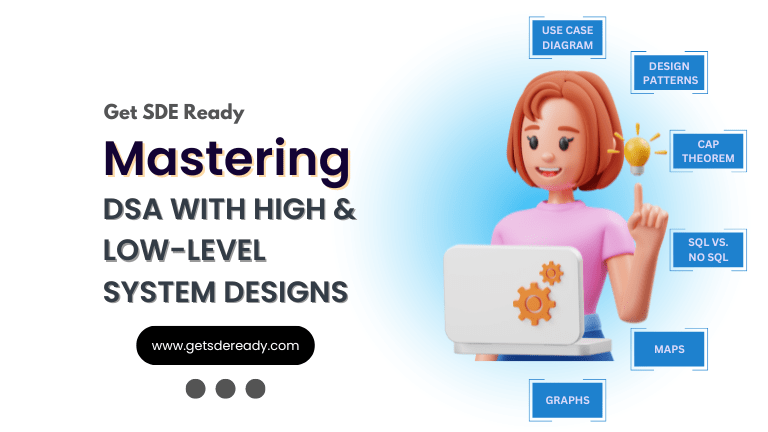
DSA, High & Low Level System Designs
- 85+ Live Classes & Recordings
- 24*7 Live Doubt Support
- 400+ DSA Practice Questions
- Comprehensive Notes
- HackerRank Tests & Quizzes
- Topic-wise Quizzes
- Case Studies
- Access to Global Peer Community
Buy for 52% OFF
₹25,000.00 ₹11,999.00
Accelerate your Path to a Product based Career
Boost your career or get hired at top product-based companies by joining our expertly crafted courses. Gain practical skills and real-world knowledge to help you succeed.
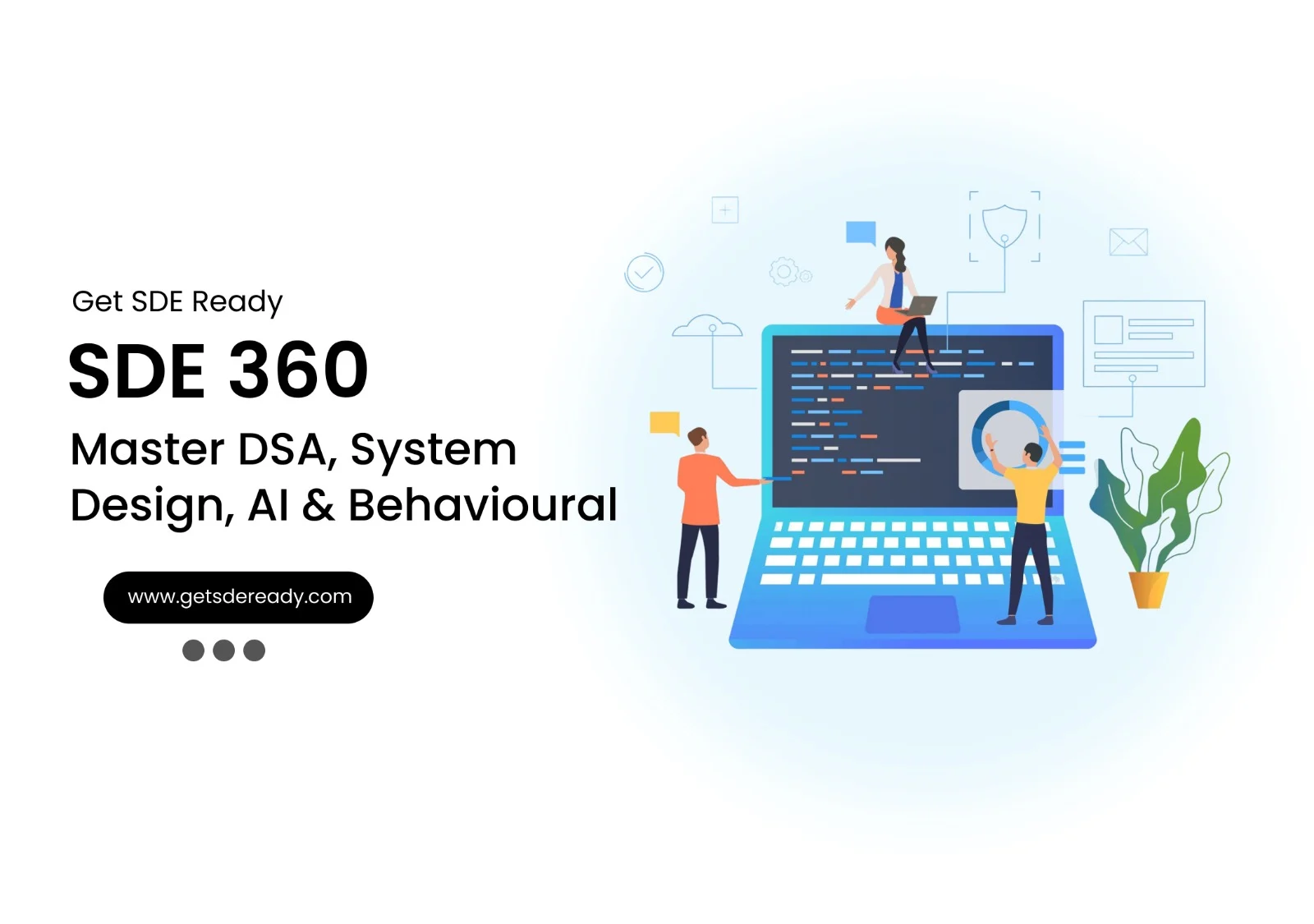
SDE 360: Master DSA, System Design, AI & Behavioural
- 100+ Live Classes & Recordings
- 24*7 Live Doubt Support
- 400+ DSA Practice Questions
- Comprehensive Notes
- HackerRank Tests & Quizzes
- Topic-wise Quizzes
- Case Studies
- Access to Global Peer Community
Buy for 50% OFF
₹39,999.00 ₹19,999.00

DSA, High & Low Level System Designs
- 85+ Live Classes & Recordings
- 24*7 Live Doubt Support
- 400+ DSA Practice Questions
- Comprehensive Notes
- HackerRank Tests & Quizzes
- Topic-wise Quizzes
- Case Studies
- Access to Global Peer Community
Buy for 52% OFF
₹25,000.00 ₹11,999.00
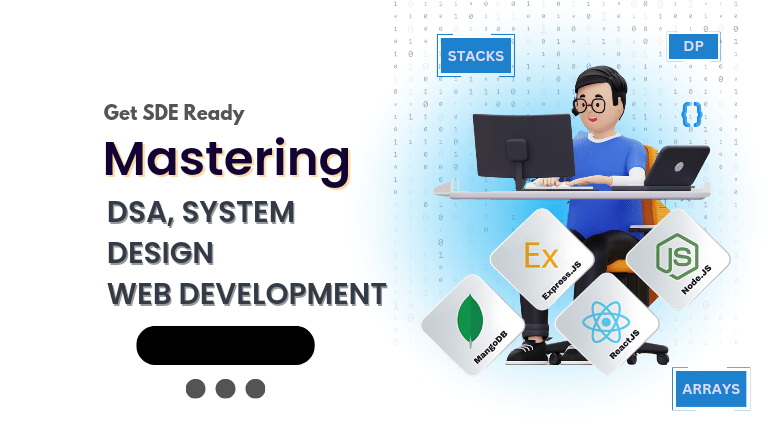
Fast-Track to Full Spectrum Software Engineering
- 120+ Live Classes & Recordings
- 24*7 Live Doubt Support
- 400+ DSA Practice Questions
- Comprehensive Notes
- HackerRank Tests & Quizzes
- 12+ live Projects & Deployments
- Case Studies
- Access to Global Peer Community
Buy for 51% OFF
₹35,000.00 ₹16,999.00
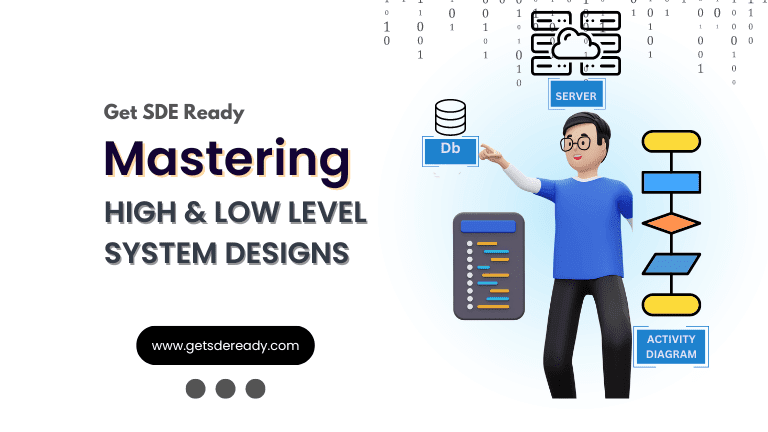
Low & High Level System Design
- 20+ Live Classes & Recordings
- 24*7 Live Doubt Support
- Case Studies
- Comprehensive Notes
- HackerRank Tests
- Topic-wise Quizzes
- Access to Global Peer Community
- Interview Prep Material
Buy for 60% OFF
₹20,000.00 ₹7,999.00
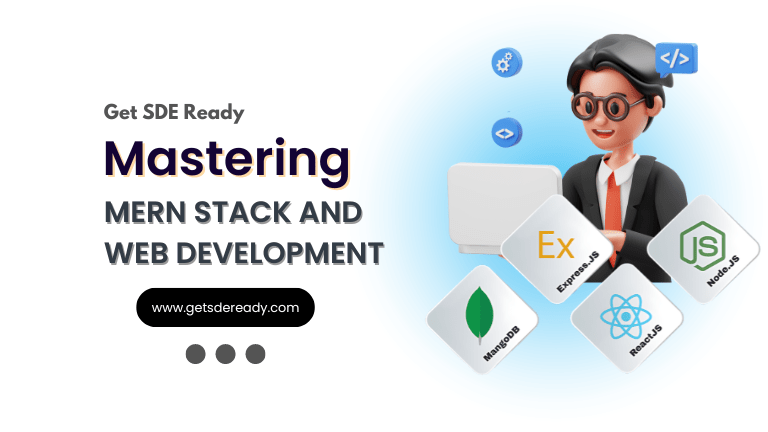
Mastering Mern Stack (WEB DEVELOPMENT)
- 65+ Live Classes & Recordings
- 24*7 Live Doubt Support
- 12+ Hands-on Live Projects & Deployments
- Comprehensive Notes & Quizzes
- Real-world Tools & Technologies
- Access to Global Peer Community
- Interview Prep Material
- Placement Assistance
Buy for 53% OFF
₹15,000.00 ₹6,999.00
Reach Out Now
If you have any queries, please fill out this form. We will surely reach out to you.
Contact Email
Reach us at the following email address.
arun@getsdeready.com
Phone Number
You can reach us by phone as well.
+91-97737 28034
Our Location
Rohini, Sector-3, Delhi-110085
